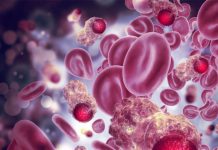A study conducted by the researchers of the University of Colorado School of Medicine has found that oxygen deprivation (hypoxia) plays a key role in cancer development.
The study findings, which were published this month in the journal Nature Communications, could help develop more targeted therapies for cancer.
Senior researcher Dr. Joaquin Espinosa and his team used genomics technologies to determine the response of cancer cells to hypoxia, according to Medical Xpress.
The researchers explain that the cellular adaptation to hypoxia is the fundamental aspect of cancer biology, particularly in solid tumors.
Study author Dr. Matthew Galbraith explained, “Most tumors cannot grow unless they figure out a way to induce the formation of new blood vessels to supply them with oxygen and other nutrients. So, what happens inside of solid tumors is they undergo intermittent periods of low oxygen between rounds of new blood vessel formation.”
Dr. Espinosa said, “We employed a cutting-edge genomics technology that nobody had employed in this field before that allowed us to see what happens to cancer cells within minutes of depriving them of oxygen.”
The genomics technology helped them to identify hundreds of hypoxia-inducible genes activated shortly upon oxygen deprivation, according to Medical Xpress, which are the ‘first responders’ in this important cellular response.
The team found that when cells are deprived of oxygen, their first reaction is to stop growing so they preserve their existing oxygen and nutrients
What they found was that when a cell is deprived of oxygen, its first reaction is to stop growing in order to preserve its existing nutrients and oxygen, and then hypoxia causes a tumor-suppressive reaction. After longer periods of hypoxia, tumors start to grow and metastasize as the cells invade neighboring tissues in search of oxygen, per Medical Xpress.
Dr. Espinosa said, “There’s been a lot of debate about whether these hypoxia-inducible factors promote tumor growth or prevent tumor growth. The conclusion we came to is that everyone was right to a degree.”
“Hypoxia-inducible factors can suppress tumor growth by preventing protein synthesis early on, but they can also advance tumor growth at later stages by promoting the ability of cancer cells to invade neighboring tissues,” he added. “It depends on when you’re looking at it.”
“These results emphasize the importance of developing inhibitors of hypoxia-inducible enzymes that degrade collagen and other components of the extracellular matrix,” Dr. Espinosa continued.
Dr. Espinosa and his colleagues hope that their findings will help in developing future therapies that can target cancer cells.
Dr. Galbraith said, “People have been trying to target the hypoxia-inducible factors with different therapeutics, but this research would suggest that you may want to exercise some caution about when you apply those therapeutics, given that the HIFs can be tumor suppressive in the early stages of hypoxia.”
“Since the hypoxic response can be tumor suppressive in some contexts and oncogenic in other contexts, it’s not a good idea to issue a blanket statement that we should always try to shut it down,” Dr. Espinosa added. “Instead, we should be thinking about what aspect of the hypoxic response to the target, and that’s the aspect where hypoxia drives invasion and metastasis.”
The team now expects to conduct follow-up studies from researchers using the map his team has created in the future.
Dr. Espinosa said, “I would say this is a definitive improvement in the mapping of the early events of hypoxia. And the beauty of that is that once you have a good map of the land, a lot of people can use it.” The article was published Wednesday on Medical Xpress.





















